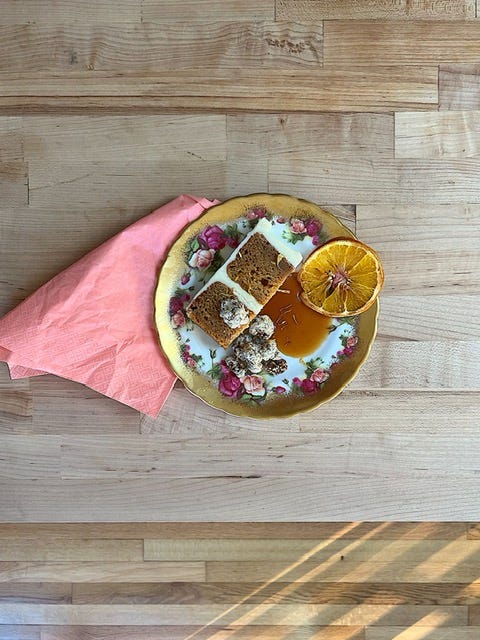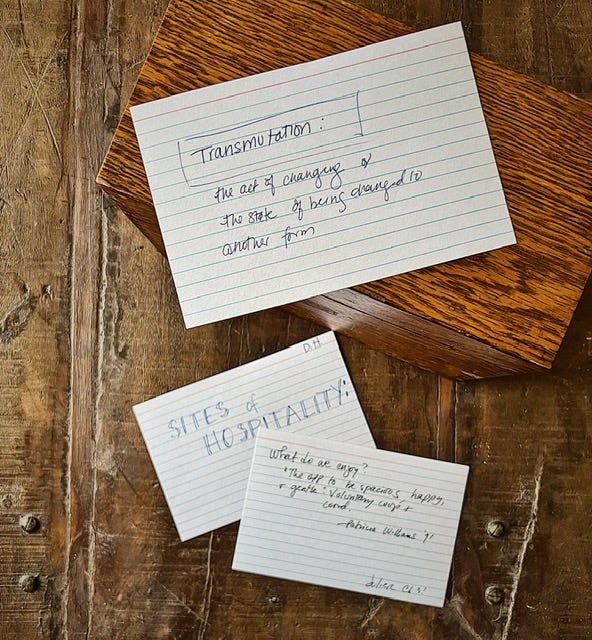When Omar Tate, creative genius and polymath behind Honeysuckle Projects (along with his equally brilliant partner/co-founder Cybille St. Aude-Tate) casually texted one night this past winter asking if I’d dust off my offsets and mixer to collaborate on an event, I agreed without hesitation. I had met Omar briefly at a dinner for which I baked celebrating Southern Black Traditions (more on that another time). In person, he embodied the generosity of spirit and groundedness I had read about and seen evidenced in his kitchen work and writing. I liked him instantly.
Even as I moved farther away from my own baking—literally packing up shop (my love letter of a baking business, Curtis & Cake) and moving from Wisconsin to Georgia, moving into an HR role at my father’s business, moving deeper into a pandemic-fueled and multi-faceted grief—even through all of this, I kept an eye on Omar, Cybille, and their gorgeous Honeysuckle Projects. Watching it grow was a joyful and sustaining thing in the way that our best love-driven and care-centered work always is.
At the time Omar texted, my own path had been obscured by circumstance. My tools and pans were still packed away god knows where, and I was very far in practice and affect from the baker I once was. I felt like I had had swung halfway across the deck: from fully inhabiting the nourishing abundance of the Empress archetype to the embodying the still resignation of the Hermit. I was doubtful about my ability to tap into the kind of life energy I thought good baking required. I knew though, that whatever happened and even if I never picked up an offset again after this mystery event, that this would be an opportunity to experience something new, to push myself beyond a comfort zone, and to learn from and cook with people I admire.
The event turned out to be a multi-course dinner hosted as part of the Charleston Wine and Food Festival, one of the South’s most anticipated food celebrations, the theme was Exploring Black Spirituality Through Food, the inspiration touchstone was Ntozake Shange’s disaporic recipe memoir If I Can Cook/You know God Can, and the date March 5th. Valerie Erwin, long-time proprietor of the famed Geechee Girl Rice Cafe, a chef and writer whose work on table and page I had long admired would join us!
I will say here, that perhaps next to the invitation itself, what I appreciate most about the opportunity extended by Omar and Cybille was the creative freedom. I really had the space to move—albeit at a hermit’s crawl— through my own process: ideation, relationship mapping, and storytelling. All this long before the first test cake got baked. I think that I think of the cakes as akin first to poems or essays and maybe then, once a kind of story has constellated, to paintings or collages. My initial ideation sessions still tend to start with the kinds of questions I’d ask my wedding clients: What impressions immediately come up for you? What story do you want to tell? What do you want people to feel?
For the Black Spirituality event, I knew I wanted people to feel the spirit-led and sustaining magic in the Black everyday. Just our beautiful regular-ness. As Omar reassured me once, “Regular is great.” The Shange of course, brought up vibrant themes of nourishment, sustenance, and spirit as well as geographies and sites of Black hospitality. I brainstormed sites of spirit-filled hospitality from my own life and the iconic Black cakes that were often associated with them. Spades: rum cake. Easter brunch and wakes: Coconut cake. Family gatherings and cookouts: pineapple upside down cake, a range of sheet cakes. Anywhere: pound cake. I considered keystone diasporic ingredients: mango and pineapple and coconut and rum. Benne, rice, hibiscus, molasses, sweet potato. I considered ingredients and associations…and came to my first resonance: (butter) milk and honey.
Milk and honey. I looked up and reread half-remembered scripture: Exodus and Song of Solomon. As a hospice volunteer, I had sat a few times with a frail but luminous octogenarian who had been a long-time nurse and A.K.A. soror. Her church’s Sunday service ran on YouTube as she slept. I reviewed the notes I took when her pastor made points that resonated with me (I have pages for a future essay from one sermon that was entirely about the differences between worldly time (chronos) and Godly time (chiros).) I recalled and referenced a text conversation I had with my devout Aunt concerning delayed reward and the linkages between sweetness and heaven. And while ideas began to cluster—I was considering a buttermilk poundcake or a tres leches that played with orange blossom honey, fennel and white pepper—the second idea I pitched won out. A sweet potato layer cake.
This cake was less of a unified concept, but more earthy. More grounded in the here and now less waiting on the hereafter. The ideas and stories it ended up holding spoke to a more personal experience of sweetness and spirit. I explored sacred themes of hidden-ness—packaged plate, burnt honey Hennessy caramel and Saturday/Sunday freedom of spirit, and the sometimes secret knowledge of the Black kitchen—that I will share more about in part II. Themes of spring and regeneration that didn’t necessarily manifest in ingredients or flavor profile but that came forth with this cake nonetheless, are what I want to talk about now.
I play favorites less and less as I get older. “Liking” things that are easy for me or that I prefer has kind of given way to a softer assumption of the gift status in all the things and situations whether I prefer them or not—and to knowing where the fault lay if I don’t initially recognize said gift. I identified as a “summer girl” for most of my life. Summer is easy. Time off, long days, wandering spirit. A no-brainer for a water-loving academic. My time in the midwest, however, taught me how to truly love Winter’s quiet gifts. I spent eight years violently resenting Chicago’s lake effect and then another five easing into awareness and acceptance of winter’s beauty in a small house in a small town in Wisconsin. I had read Katherine May’s quietly beautiful book Wintering my first mild winter back in Georgia after those chilly trials and realized how much winter I had internalized. I knew with intimacy the steely and silent places winter had come to nestle in my soul. Once discovered and made friends with, those inhabited places don’t get cleared out like the guest bedroom because you prefer to pay attention to other, warmer quarters of your being. In time, all seasons, to some extent or other, take up tenancy your soul’s house. They prompt you to the appropriate rituals of deep care when time calls for them. This is a way of understanding seasonality.
Like Winter, Spring too, appears to the soul bearing gifts. It is how wildness brings lessons of redemption, forgiveness, compassion, tenderness, regeneration, renewal and faith restored. We might, in Spring, be coaxed to slowly shift proclivity outward, to begin to share the insights gained during Winter months, to try again to be strong enough to be vulnerable. To be foolhardy enough to try again, for surely, if winter’s card is The Hermit, Spring’s is that of the open-hearted, capacious Fool.
In The Taste of Country Cooking, a kind of seasonality bible for me, Edna Lewis’s writing on Spring certainly offers the language of the lamb and of an “abundance of milk and butter, as well as buttermilk, rich with flecks of butter.” Sure, her folks would “gather wild honey from the hollow of oak trees…and pick wild strawberries to go with the heavy cream,” but spring for her and hers was also a time to start work and to express care. She reminds us: “ People also helped each other by trading seed, setting hens, and exchanging ideas.”
The work of Lewis’s community involved all of the field work and preparation associated with planting season. I, however, don’t live embedded in a farming community. I buy nearly all my food from others. So I tend to understand and practice ‘the work of Spring’ in terms of that last action on Ms. Lewis’s list: helping myself and others—through material exchanges but also the non-material. The exchange of ideas. Of thoughtfulness, connection, care. All Winter I will have retreated in, tended wounds, sat in and awed by silence or by the fire, kept company with shadow and grief, and found comfort in blankets and books. Spring requires me to leave the dark shelter, venture outside, exchange ideas and share secrets (first with plants, then people). I will have meditated on questions such as How do I keep the grief and the joy engaged in fruitful dance ? What techniques did my ancestors use to slowly become part of the world again and again? What story do I want to tell? Maybe some springs the answers to these questions look like dusting off the offsets and mixing bowls. Accepting a friend’s invitation. Shoring up faith and courage. Making something beautiful with and for others. Being just foolish enough …to start over.
How is your Spring transforming? xx





